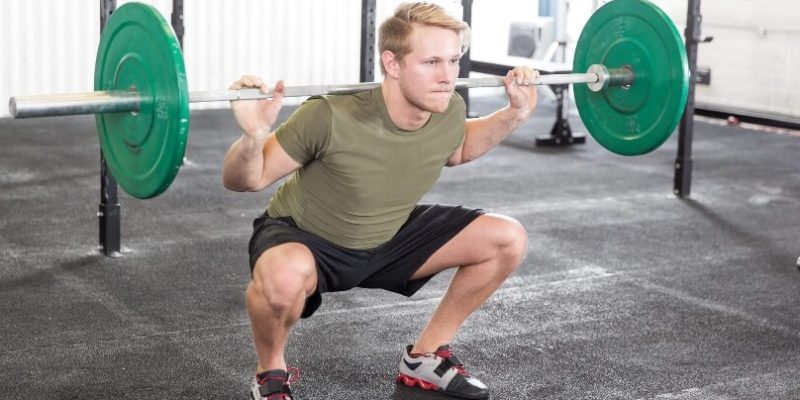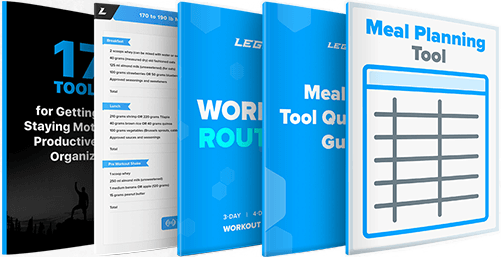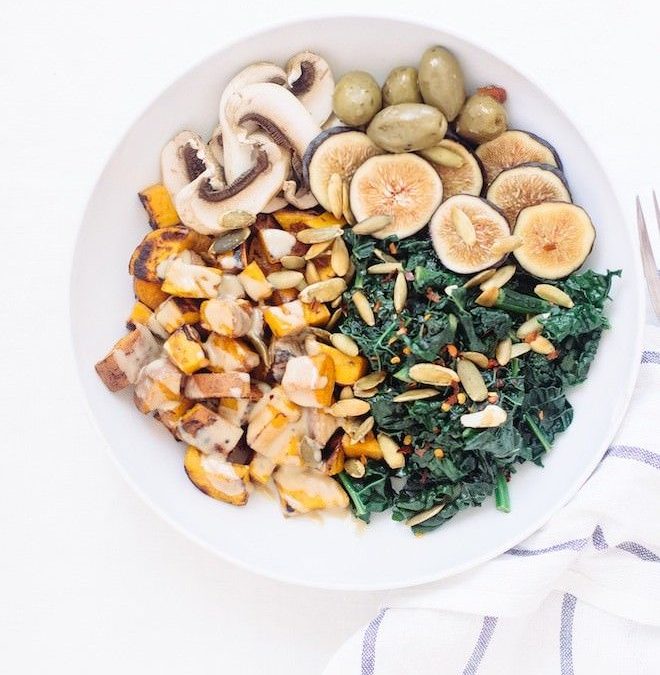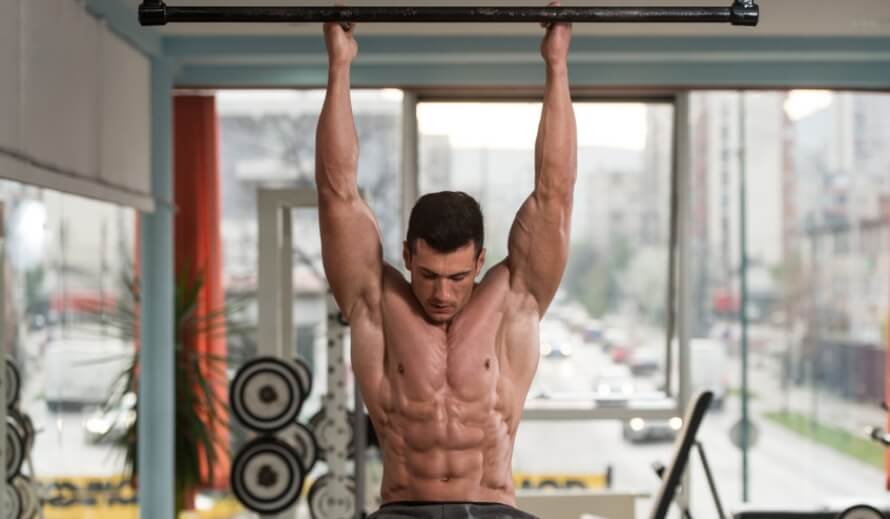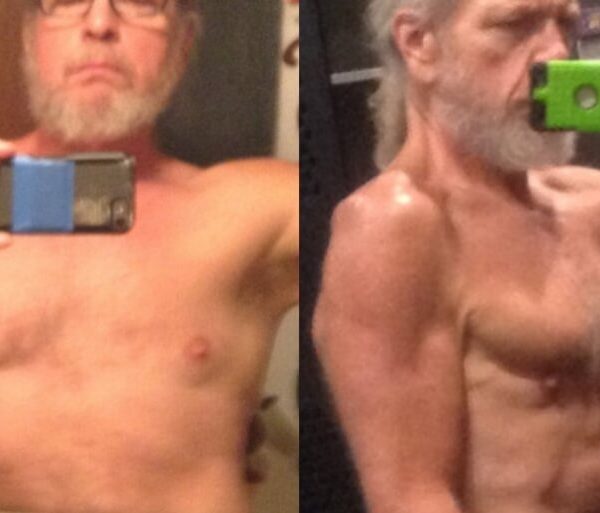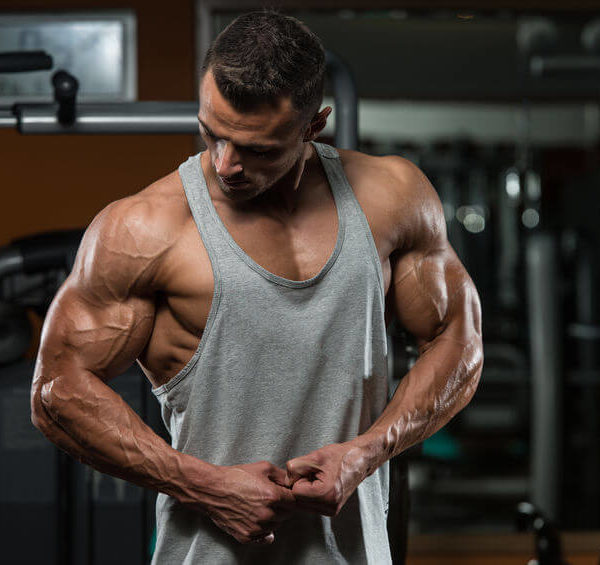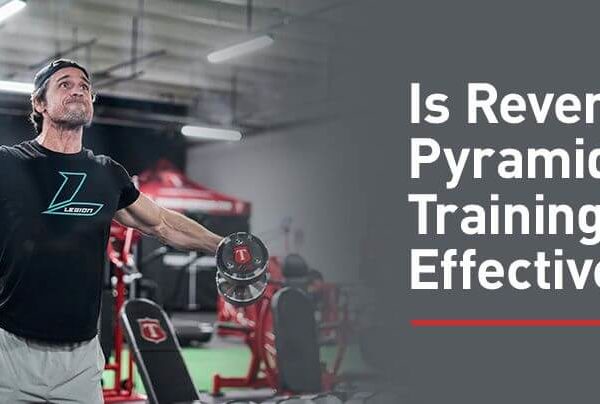The Best Leg Workout Routine for Building Mass & Hypertrophy
Most guys would rather have big pecs, shoulders, and biceps over a big set of wheels, and who can fault them?
Having a muscular, defined upper body feels and looks good.
That said, the fact that you’re reading this tells me that you understand the importance of having big, strong legs, too.
Not only do strong, muscular legs improve your performance on exercises like the squat and deadlift, they also help balance your upper body development, giving you the “X” physique most guys are after.
If you peruse many articles on the best leg workouts for mass, though, you can easily come away thinking that you need to grind yourself to a pulp with grueling lower-body workouts to make any progress.
This is silly, and wrong, and unscientific. In fact, trying to do too much, too fast, is one of the worst mistakes you can make, as it quickly leads to injury, burnout, and a plateau in your strength.
The truth is that although compound leg workouts are some of the most challenging you can do (which is why most people shirk them), you don’t need to run yourself ragged to achieve leg hypertrophy.
In fact, the best leg workouts involve just a handful of exercises for a relatively low number of sets and reps, that you only need to do once per week.
And that’s the kind of leg workout you’re going to get in this article.
You’ll learn . . .
- Which muscles you need to train in your leg workouts for mass
- A full leg workout for adding serious size to your lower body
- A leg strength workout to help you get stronger on the squat and deadlift
- A power leg workout to help you develop explosive power
Lower-Body Anatomy
Full leg workouts for mass train every major lower-body muscle group, which includes the quadriceps, hamstrings, glutes, and calves. Let’s take a moment to look at these muscles in more detail.
Quadriceps
The quadriceps are the four large muscles on the front of your thigh: the vastus lateralis (or outer quad), the vastus medialis (or inner quad), the vastus intermedius, and the rectus femoris (both of which make up the middle quad).
The quadriceps muscles work together to extend (straighten) the knee. Because the rectus femoris attaches to the ilium (hip), it also helps you bend at the hips (this means the rectus femoris is also a hip flexor).
Hamstrings
The hamstrings are the group of three muscles on the back of your thigh: the biceps femoris, the semimembranosus, and the semitendinosus.
The hamstrings work together to bend the knee and extend your hips. In other words, they move your feet toward your butt and move your abdomen away from your thighs.
Glutes
The gluteal muscles, more commonly known as the “glutes,” are the three muscles that make up your buttocks: the gluteus maximus, the gluteus minimus, and the gluteus medius.
The glutes are responsible for extension, abduction, and external and internal rotation of the hip joint. In other words, they move your abdomen away from your thighs, they move your thighs further away from each other, and they rotate your leg inward and outward.
Calves
The calf muscles are situated on the back of your lower legs, and are made up of two muscles: the gastrocnemius, and the soleus.
These two muscles work together to flex your ankle (point your toes toward the floor), and the gastrocnemius is involved in flexing the knee, too.
The Best Leg Workout for Mass
Barbell Back Squat
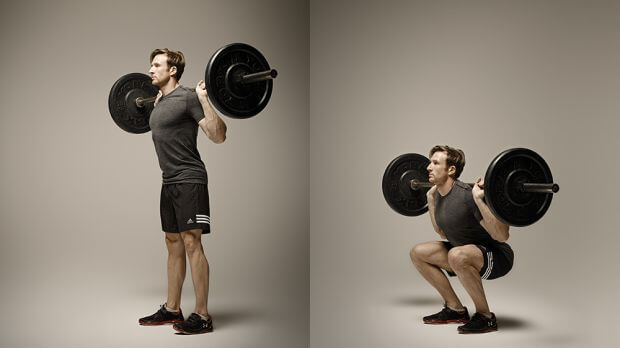
Sets: 3 | Reps: 6-to-8 | Rest: 2-to-3 min
How: Position a barbell in a squat rack at about the height of your nipples. Step under the bar, pinch your shoulder blades together, and rest the bar directly above the bony ridges on the bottom of your shoulder blades. Lift the bar out of the rack, take one or two steps backward, and place your feet a little wider than shoulder-width apart with your toes pointing slightly outward. Sit down and remember to keep your back straight and push your knees out in the same direction as your toes throughout each rep, then stand up and return to the starting position.
Why: The barbell back squat is hands down the most effective leg exercise you can do for building whole-body size and strength. It also allows you to use very heavy weights, which maximizes tension on your muscle fibers and thus muscle growth over time.
Barbell Front Squat
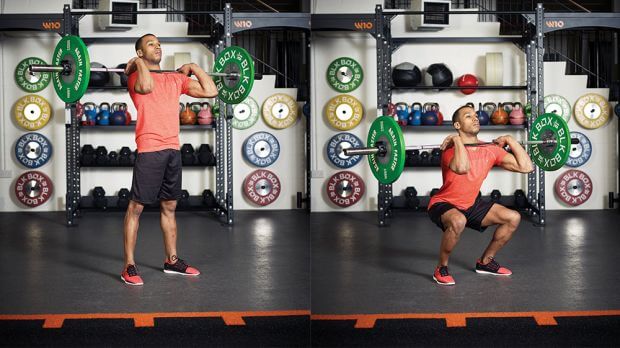
Sets: 3 | Reps: 6-to-8 | Rest: 2-to-3 min
How: Position a barbell in a squat rack at about the height of your breast bone (usually an inch or two higher than you would for the barbell squat). Grab the bar with a shoulder-width grip and your palms facing away from you. Step closer to the bar so that it presses against the top of your breast bone and push your elbows up and out in front of the bar.
With the bar resting on the front of your shoulders and held in place by your hands, lift it out of the rack, take one or two steps backward, and place your feet a little wider than shoulder-width apart with your toes pointing slightly outward. Sit down and remember to keep your back straight, elbows up, and push your knees out in the same direction as your toes throughout each rep. Stand up and return to the starting position.
Why: Research shows that the front squat trains the quads just as effectively as the back squat, even when you use up to 20% less weight. What’s more, research also shows that the front squat places considerably less compressive forces on your knees and lower back, which make it a particularly good alternative to back squats for people who have knee or back issues.
Romanian Deadlift
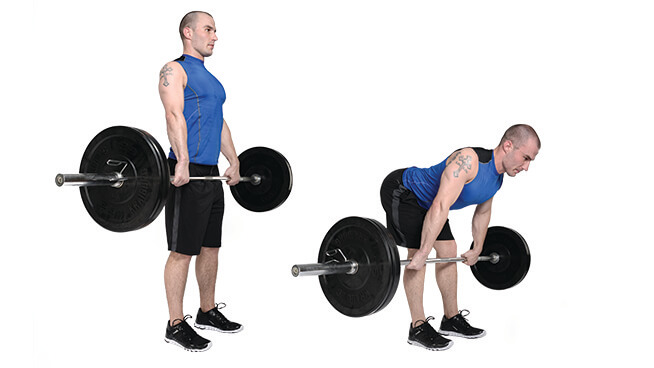
Sets: 3 | Reps: 8-to-10 | Rest: 2-to-3 min
How: Stand up straight holding a loaded barbell with a shoulder-width grip and your hands facing toward you. Flatten your back and lower the weights toward the floor in a straight line while keeping your legs mostly straight, allowing your butt to move backward as you descend.
Once you feel a stretch in your hamstrings, bend your knees slightly more, and continue lowering the weights until your lower back begins to round—just below the knees for most people, and about mid-shin for those who are particularly flexible. Reverse the movement and return to the starting position.
Why: The Romanian deadlift (RDL) trains the posterior chain in a very similar way to the conventional deadlift. However, because of the difference in form, you put a greater emphasis on your hamstrings and glutes rather than your back. It’s also considerably less fatiguing than the conventional deadlift, which means you can do it more often without wearing yourself to a frazzle.
Bulgarian Split Squat
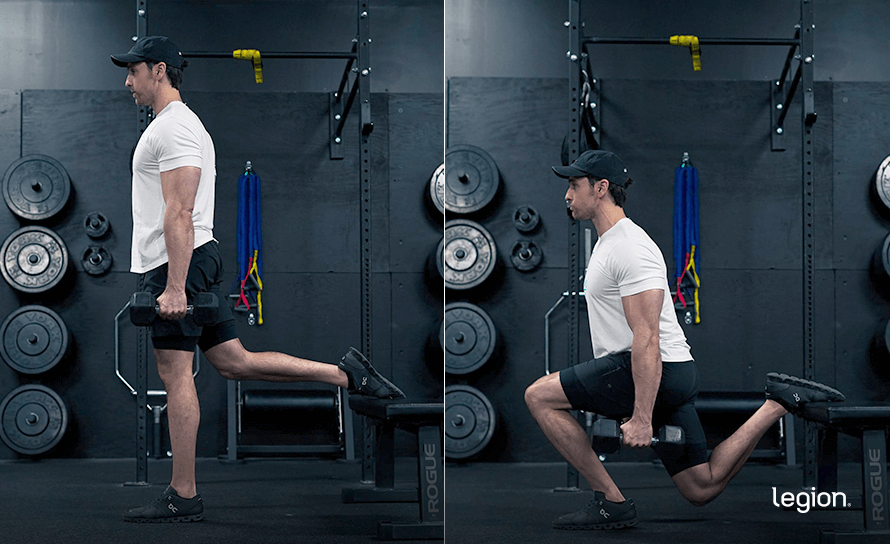
Sets: 3 | Reps: 8-to-10 | Rest: 2-to-3 min
How: While holding a dumbbell in each hand, stand about two-to-three feet in front of a bench with your back to the bench. With your right foot (and heel in particular) firmly planted, place the top of your left foot on the bench behind you. Look at a spot on the floor six-to-ten feet in front of you and lower your butt toward the floor by bending at your right knee. Keep lowering yourself until your right thigh is roughly parallel with the floor. Stand up and return to the starting position.
Why: Research shows that the dumbbell Bulgarian split squat is a great exercise for training the glutes and the quads. Because the Bulgarian split squat trains just one leg at a time, it’s particularly useful for identifying and evening out any muscle or strength imbalances you might have, too.
Seated Calf Raise
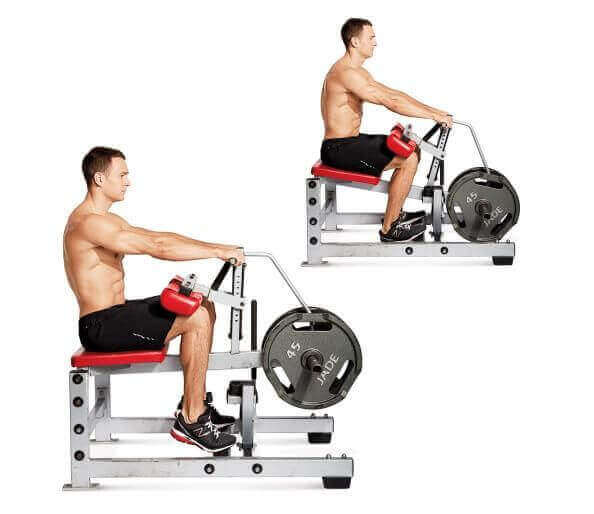
Sets: 3 | Reps: 10-to-15 | Rest: 2-to-3 min
How: While seated, adjust the thigh pad so that it rests just above your knee and place the balls of your feet on the footplate. Lift the pad slightly by pointing your toes, and use the safety handle to release the weight. While keeping your feet on the footplate, lower the weight as far as possible by letting your heels move toward the floor. Then, push through the balls of your feet to elevate the thigh pad as high as you can.
Why: The seated calf raise helps you build mass and strength in your calves which is important if you want to run faster, jump higher and further, and improve stability during lower-body exercises like the squat and deadlift. It also helps improve your muscular proportions to achieve a more symmetrical, “aesthetic” physique.
Leg Workouts for Mass Tips
1. Do compound leg workouts.
A compound exercise is any type of exercise that trains several major muscle groups at the same time, and research shows that these are the best exercises for gaining mass and strength.
Exercises that emphasize just one joint and muscle group at a time—also known as isolation exercises—still have a place in your leg workouts, but if building leg mass is your main goal, you want to put most of your effort into compound leg exercises.
If you want to learn more about the difference between compound and isolation exercises, check out this article:
Are Compound Exercises Better Than Isolation Exercises?
2. Lift heavy weights.
As a natural weightlifter, your number one goal should be getting stronger.
So long as you make that your primary focus in your training, you’ll have no trouble with leg hypertrophy.
What’s the best way to get stronger?
Lift heavy.
And by “heavy,” I mean working primarily with weights in the range of 75-to-85% of your one-rep max, or in the range of 8-to-10 (~75%) to 4-to-6 (~85%) reps, and taking most of your sets within a few reps shy of muscular failure (the point at which you can’t do another rep with proper form).
Higher-rep sets (10+) can still be used to good effect in leg workouts for mass, but they should be used sparingly (especially on compound exercises like squats).
3. Emphasize progressive overload.
Progressive overload refers to making your workouts more challenging over time, and it’s important because it’s one of the best ways to maximize the muscle-building effects of weightlifting.
When you’re new to lifting weights, the simplest and most effective way to do this is to strive to add weight or reps to every exercise in every workout. If you bench pressed 135 for 5 reps last week, you try to bench press 145 for 5 reps this week. It’s that simple.
This forces your muscles to produce greater and greater levels of tension over time, which in turn helps you grow bigger and stronger.
If you want to learn more about the best ways to implement progressive overload, check out this article:
What Is Progressive Overload Training?
4. Eat enough calories and protein.
In order to maximize leg muscle growth you need to maintain a mild calorie surplus.
That is, you need to eat about 110% of your total daily energy expenditure (TDEE) every day.
The reason for this is a calorie surplus optimizes your body’s “muscle-building machinery,” greatly enhancing your ability to recover from and positively adapt to your training.
That’s not all, though—you need to eat enough protein to allow your muscles to recover, repair, and grow effectively, too.
For most people, that means eating 0.8-to-1 gram of protein per pound of body weight per day.
If you want to learn exactly how many calories you should eat maximize leg hypertrophy, check out this article:
How Many Calories Should I Eat?
5. Take the right supplements.
I saved this for last because it’s the least important.
Unfortunately, no amount of pills and powders are going to automagically make your legs bigger.
But here’s the good news:
If you know how to eat and train to build muscle—following the steps we just covered—certain supplements can speed up the process.
Here are the best supplements for building leg mass:
- 0.8-to-1.2 grams of protein per pound of body weight per day. This provides your body with the “building blocks” it needs to build and repair muscle tissue and help you recover from your leg workouts. If you want a clean, convenient, and delicious source of protein, try Whey+ or Casein+.
- 3-to-5 grams of creatine per day. This will boost muscle and strength gain, improve anaerobic endurance, and reduce muscle damage and soreness from your compound leg workouts. If you want a 100% natural source of creatine that also includes two other ingredients that will help boost muscle growth and improve recovery, try Recharge.
- One serving of Pulse per day. Pulse is a 100% natural pre-workout drink that enhances energy, mood, and focus; increases strength and endurance; and reduces fatigue. You can also get Pulse with caffeine or without.
FAQ #1: What’s the difference between a leg workout for mass and a leg strength workout?
Leg strength workouts . . .
- Emphasize sets of lower reps (usually 6 or fewer) over sets of higher reps (usually ~7-12+) because lower rep ranges allow you to move the most weight.
- Often employ slightly longer rest periods to ensure that you can maintain proper technique when using very heavy loads.
If you want to change the above leg hypertrophy workout into a leg strength workout, here’s a good way to go about it:
- Barbell Back Squat: Sets: 3 | Reps: 3-to-5 | Rest: 3-to-5 min
- Barbell Front Squat: Sets: 3 | Reps: 3-to-5 | Rest: 3-to-5 min
- Romanian Deadlift: Sets: 3 | Reps: 6-to-8 | Rest: 3-to-5 min
- Bulgarian Split Squat: Sets: 3 | Reps: 8-to-10 | Rest: 2-to-3 min
- Seated Calf Raise: Sets: 3 | Reps: 10-to15 | Rest: 2-to-3 min
FAQ #2: What do you have to change to create a power leg workout?
Power refers to generating as much strength as quickly as possible, but not necessarily the most absolute strength.
Most people work out because they want to build muscle, lose fat, and stay healthy. This is best achieved by doing a mixture of strength and hypertrophy training, rather than power workouts, which involve performing your reps as quickly as possible with relatively light weights (usually no more than ~70% of your one-rep max.
That said, if you do want to increase your leg power, here are some general recommendations:
- Start your power leg workouts with exercises that allow you to lift weights explosively, such as the power clean or jump squat, or by doing a regular squat, deadlift, and so forth with light weights as quickly as possible.
- Pick a weight that’s about ~70% of your one-rep max and do 3 sets of 3-to-5 reps, resting at least 2-to-3 minutes between each set.
- Finish your workout with several compound leg exercises in the 4-to-6- and 8-to-10-rep ranges, like this:
Barbell Back Squat: Sets: 3 | Reps: 4-to-6 | Rest: 3-to-5 min
Barbell Front Squat: Sets: 3 | Reps: 8-to-10 | Rest: 2-to-3 min
Romanian Deadlift: Sets: 3 | Reps: 8-to-10 | Rest: 2-to-3 min
FAQ #3: How many days a week should I train for leg hypertrophy?
If you want to develop any major muscle group, including your legs, it’s normally best to train it with a total of 10-to-20 weekly sets.
People who’ve been following a proper strength training program for less than two years should aim for 10-to-15 weekly sets (like the workouts included in this article), whereas those who’ve been training properly for more than two years should aim for 15-to-20 weekly sets.
Doing 10-to-15 sets in a single workout is very doable, but if you’re doing 15+ weekly sets, you’ll probably find that the quality of your sets begins to suffer as your workout drags on. In this case, the best solution is normally to divide those weekly sets over two or even three workouts, which prevents you from getting too fatigued in any single session.
If you want to know more about how much and how often you should train, check out this article:
The Best Training Frequency for Building Muscle (According to 20 Studies)
+ Scientific References
- Henselmans, M., & Schoenfeld, B. J. (2014). The Effect of Inter-Set Rest Intervals on Resistance Exercise-Induced Muscle Hypertrophy. In Sports Medicine (Vol. 44, Issue 12, pp. 1635–1643). Springer International Publishing. https://doi.org/10.1007/s40279-014-0228-0
- Stokes, T., Hector, A. J., Morton, R. W., McGlory, C., & Phillips, S. M. (2018). Recent perspectives regarding the role of dietary protein for the promotion of muscle hypertrophy with resistance exercise training. In Nutrients (Vol. 10, Issue 2). MDPI AG. https://doi.org/10.3390/nu10020180
- Helms, E. R., Aragon, A. A., & Fitschen, P. J. (2014). Evidence-based recommendations for natural bodybuilding contest preparation: Nutrition and supplementation. In Journal of the International Society of Sports Nutrition (Vol. 11, Issue 1, p. 20). BioMed Central Ltd. https://doi.org/10.1186/1550-2783-11-20
- Gonzalez, A. M., Hoffman, J. R., Stout, J. R., Fukuda, D. H., & Willoughby, D. S. (2016). Intramuscular Anabolic Signaling and Endocrine Response Following Resistance Exercise: Implications for Muscle Hypertrophy. In Sports Medicine (Vol. 46, Issue 5, pp. 671–685). Springer International Publishing. https://doi.org/10.1007/s40279-015-0450-4
- Schoenfeld, B. J. (2010). The mechanisms of muscle hypertrophy and their application to resistance training. In Journal of Strength and Conditioning Research (Vol. 24, Issue 10, pp. 2857–2872). J Strength Cond Res. https://doi.org/10.1519/JSC.0b013e3181e840f3
- Gentil, P., Soares, S., & Bottaro, M. (2015). Single vs. Multi-joint resistance exercises: Effects on muscle strength and hypertrophy. Asian Journal of Sports Medicine, 6(2), 1–5. https://doi.org/10.5812/asjsm.24057
- Wojtys, E. M., Huston, L. J., Taylor, P. D., & Bastian, S. D. (1996). Neuromuscular adaptations in isokinetic, isotonic, and agility training programs. American Journal of Sports Medicine, 24(2), 187–192. https://doi.org/10.1177/036354659602400212
- Slater, L. V., & Hart, J. M. (2017). Muscle Activation Patterns during Different Squat Techniques. Journal of Strength and Conditioning Research, 31(3), 667–676. https://doi.org/10.1519/JSC.0000000000001323
- Jones, M. T., Ambegaonkar, J. P., Nindl, B. C., Smith, J. A., & Headley, S. A. (2012). Effects of unilateral and bilateral lower-body heavy resistance exercise on muscle activity and testosterone responses. Journal of Strength and Conditioning Research, 26(4), 1094–1100. https://doi.org/10.1519/JSC.0b013e318248ab3b
- Gullett, J. C., Tillman, M. D., Gutierrez, G. M., & Chow, J. W. (2009). A biomechanical comparison of back and front squats in healthy trained individuals. Journal of Strength and Conditioning Research, 23(1), 284–292. https://doi.org/10.1519/JSC.0b013e31818546bb
- Yavuz, H. U., Erdağ, D., Amca, A. M., & Aritan, S. (2015). Kinematic and EMG activities during front and back squat variations in maximum loads. Journal of Sports Sciences, 33(10), 1058–1066. https://doi.org/10.1080/02640414.2014.984240
If you enjoyed this article, get weekly updates. It’s free.
Sending…
Great! You’re subscribed.
100% Privacy. We don’t rent or share our email lists.

